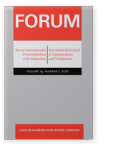Article published In:
FORUMVol. 14:2 (2016) ► pp.194–210
Self-monitoring processes in simultaneous interpreting
In psycholinguistics there is an agreement that self-monitoring is part of the speech production system, it serves the repair of speech errors and disfluencies occurring during the process of speech production.
During simultaneous interpreting, where source language speech perception and target language speech production happen simultaneously, the analysis of self-monitoring is of particular importance.
In our study we compare self-monitoring processes in the target language texts, interpreted from English into Hungarian, of professional interpreters and trainee interpreters.
We examine the frequency of incidence of error – type disfluencies, the editing phase of self-repairs, the frequency of incidence of disfluencies, and the editing phases of repetitions and restarts.
Although our data have revealed considerable individual differences between interpreters, some tendencies can be detected. In general, differences can be detected in self-monitoring between professional and trainee interpreters. When compared to data about self-monitoring processes in spontaneous, monolingual Hungarian speech, we can state that there were far fewer phenomena connected to self-monitoring in the target language output of simultaneous interpreters than in monolingual Hungarian texts.
Article outline
- 1.Introduction
- 2.Procedure
- 3.Results
- 3.1Pauses and hesitations
- 3.2Repetitions
- 3.3Restarts
- 3.4Error-type disfluencies
- 3.5Content analysis of the TL texts
- 4.Discussion
- Note
-
References
References (20)
Bakti, Mária and Bóna, Judit
2014 “
The Effect of Source Language Disfluencies on the Target Language Output of Simultaneous Interpreters.” In
Papers in Language Acquisition, Language Learning and Speech Research. Studies in Psycholinguistics 41., ed. by
Bátyi Szilvia,
Navracsics Judit and
Vígh-Szabó Melinda, 121–129. Budapest-Veszprém: Gondolat Kiadó-Pannon Egyetem MFTK.

Bóna, Judit
2011 “
Disfluencies in the Spontaneous Speech of Various Age Groups: Data from Hungarian.”
Govor 28(2): 95–115.

Clark, Herbert and Wasow, Thomas
1998 “
Repeating Words in Spontaneous Speech.”
Cognitive Psychology 371: 201–242.


G. Láng, Zsuzsa
2002 Tolmácsolás felsőfokon: a hivatásos tolmácsok képzéséről. Budapest: Scholastica.

Gerver, David
1976 “
Empirical Studies of Simultaneous Interpretation: A Review and a Model.” In
Translation. Application and Research, ed. by
Richard W. Brislin, 165–207. New York: Gardner Press.

Gósy, Mária
2005 Pszicholingvisztika. Budapest: Osiris Kiadó.

Gósy, Mária
2007 “
Disfluencies and Self-monitoring.”
Govor 261: 91–110.

Gyarmathy, Dorottya
2009 “
A beszélő bizonytalanságának jelzései: ismétlések és újraindítások.” In
Beszédkutatás 2009., ed. by
Gósy Mária, 196–216. Budapest: MTA Nyelvtudományi Intézet.

Levelt, Willem J. M.
1989 Speaking. From Intention to Articulation. Cambridge MA: MIT Press.

Nooteboom, Sieb
2005 “
Lexical bias revisited: Detecting, rejecting and repairing speech errors in inner speech.”
Speech Communication 471: 43–58.


Pöchhacker, Franz
1995 “
Slips and Shifts in Simultaneous Interpreting.” In
Topics in Interpreting Research, ed. by
Jorma Tommola, 73–90. Turku: The University of Turku, Centre for Translation and Interpreting.

Postma, Albert
2000 “
Detection of errors during speech production: a review of speech monitoring models.”
Cognition 771: 97–131.


Postma, Albert and Kolk, Herman
1993 “
The covert repair hypothesis: prearticulatory repair processes in normal and stuttered disfluencies.”
Journal of Speech and Hearing Research 391: 472–487.


Shattuck-Hufnagel, Stefanie
1979 “
Speech Errors as Evidence for a Serial-Ordering Mechanism in Sentence Production.” In
Sentence Processing: Psycholinguistic Studies Presented to Merrill Garrett, ed. by
William Cooper and
Edward Walker, 295–342. Hillsdale NJ: Lawrence Earlbaum.

Spiller-Bosatra, Edith and Daró, Valeria
1992 “
Delayed Auditory Feedback Effects on Simultaneous Interpreters.”
The Interpreters’s Newsletter 41: 8–14.

Van Besien, Fred and Meuleman, Chris
2004 “
Dealing with Speakers’ Errors and Speakers’ Repairs in Simultaneous Interpretation.”
The Translator 10 (1): 59–81.


Cited by (2)
Cited by 2 other publications
Shen, Mingxia & Junying Liang
2021.
Self-repair in consecutive interpreting: similarities and differences between professional interpreters and student interpreters.
Perspectives 29:5
► pp. 761 ff.

Magnifico, Cédric & Bart Defrancq
This list is based on CrossRef data as of 2 july 2024. Please note that it may not be complete. Sources presented here have been supplied by the respective publishers.
Any errors therein should be reported to them.
